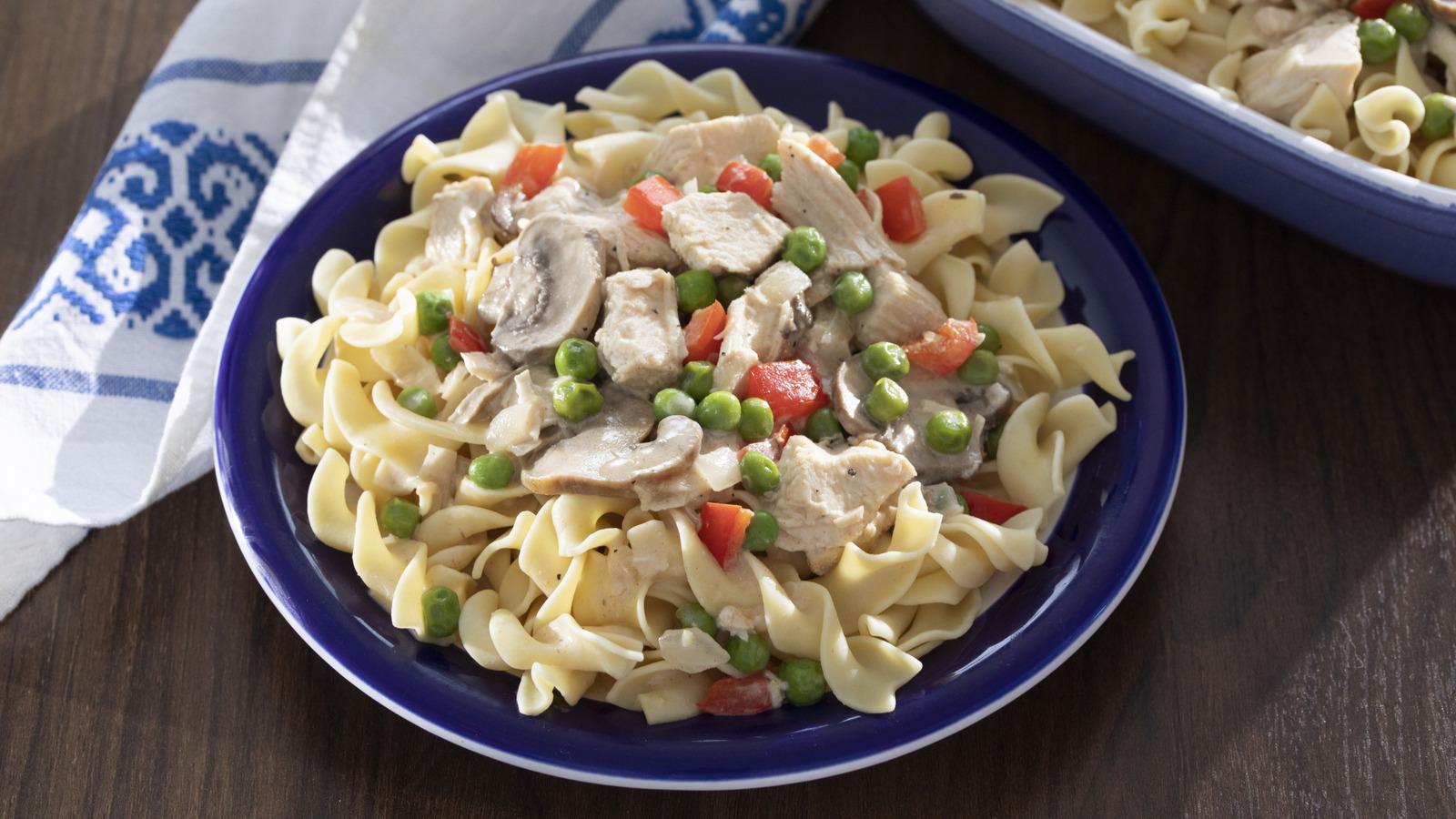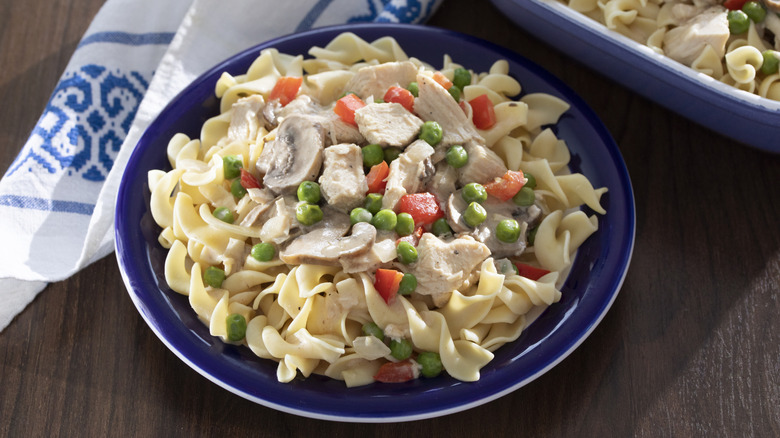
Photokitchen/Getty Images
Chicken is one of the most popular meats in the world. Humans have been cooking and eating chickens for centuries, and the ways in which it was consumed were vast and versatile. Few chicken dishes can claim the centuries-long history of fried chicken, or the impressive endurance of chicken mole from Mexico. The old-school chicken dishes we're talking about here had the opposite effect — people almost completely forgot about them.
We see it all the time. Food fads that are hot for a while then become the culinary equivalent of cassette tapes and Pokémon Go. Since chicken is near-universal, recipes centered around it have popped up all over the world, but some of them turned out to be too old-fashioned to last. What makes some chicken dishes carry on while others slip through the sands of time?
A chicken dish can fall out of public favor for several reasons. For one, certain chicken dishes were niche to begin with and never gained enough of a following to persevere. Others were high-maintenance or overly formal, and as people's tastes modernized, these fussy entrees became relics of eras gone by. Other cultural shifts factored in too. Funky casseroles from mid-century America or dishes conceived during food rations or other times of economic need were replaced with more timeless ingredients. This is a glimpse into chicken's storied past with these old-school dishes — a few of them might be worth recreating.
Chicken à la Marengo
The saucy, savory, and largely forgotten chicken à la Marengo was a favorite of French Emperor Napoleon Bonaparte, and like most things Napoleon adored, it was made in his honor. The origin story of chicken à la Marengo has been hotly contested, as centuries'-old foods tend to be. One of the most widespread accounts claims that the dish was created in June 1800 after Napoleon's army narrowly defeated the Austrian army at the Battle of Marengo, in Northern Italy. Napoleon's chef, Dunant, set out to prepare a celebratory meal using only the local ingredients at his disposal.
Dunant sautéed chicken in oil, garlic, and tomato, then topped it with crayfish and fried eggs. When Dunant made chicken a la Marengo again, he Frenchified it by swapping the crawfish for mushrooms and adding wine. Napoleon wouldn't eat it though, insisting that a deviation in the recipe could bring him bad luck. Though the veracity of this story has been debated, one thing historians can agree on is that chicken à la Marengo was created for Napoleon and was modeled after chicken a la Provençale, another favorite of the sassy, soon-to-be Emperor.
Chicken à la Marengo has been reinterpreted many times and numerous ingredients from the early recipe (Dunant documented his in 1809), have been changed. Mushrooms and olives often stand in for the crawfish and fried eggs. Some versions even substitute the chicken for rabbit or veal, turning chicken à la Marengo into something Napoleon wouldn't recognize.
Chicken divan
Casseroles were huge in the mid-20th century, but they were more closely associated with family dinners at home than the tabletops of metropolitan restaurants. Chicken divan rejected the limitation of casserole as a humble domestic meal. It was born in the Divan Parisien restaurant, a former New York City establishment known for its plush banquette seating ("divan" typically refers to a padded bench-style seat). The restaurant enjoyed Midtown locations in the (now demolished) Hotel Chatham and in the Murray Hill neighborhood. Chicken divan was its claim to fame.
Since Divan Parisien knew it had something special, details surrounding chicken divan's inception and ingredients aren't clear cut. The general consensus is that chicken divan came about circa the 1930s. It was a casserole of sliced, poached chicken and broccoli spears, smothered in a cheesy, béchamel sauce done up in the French style. Divan Parisien brought refinement to the casserole. It also helped popularize the use of broccoli in restaurant food — commercially farmed broccoli was a relatively new phenomenon when chicken divan came on the scene.
Chicken divan was forgotten because home cooks oversimplified its flavors. Poached slices of chicken were replaced by day-old chunks of bird. Béchamel — one of the mother sauces of French cuisine — was omitted in exchange for creamy condensed soup and a sprinkle of shredded cheese. As chicken divan regressed into basic casserole territory, what was achieved at Divan Parisien also retreated into the distance.
Chicken Kiev

Lenazap/Getty Images
Few dishes walk the line between fine dining and comfort food as gracefully as Chicken Kiev. Butter wrapped in chicken wrapped in breadcrumbs is a hearty order, yet finesse is required to pull off a perfect Chicken Kiev recipe. Chicken Kiev's heyday was in the 1960s — there's even a "Mad Men" episode where multiple characters keep name-dropping it. Chicken Kiev wasn't able to transcend its label as a retro meal, which is why few people remember it today.
The dish got its start long before the '60s — and not in Kiev. Throughout the 1800s, French and Russian culture shared table space. Members of the Russian aristocracy found French haute cuisine irresistible (despite political clashing between the two nations). Russian chefs who trained in Paris brought back a recipe called the Mikhailovska cutlet that was similar in format to Chicken Kiev but called for veal. At the time, Russians considered chicken to be more high-end than veal, so chicken became the choice protein for the dish.
It's been said that the Mikhailovska cutlet's filling was changed from cheese to butter in Ukraine and this was the version adopted by restaurants in the U.S. — hence the name change. By the 1940s, metropolitan restaurants in the U.S., like New York City's Russian Tea Room were serving Chicken Kiev, adding garlic and herbs to the buttery center. The Russian Tea Room is one place that hasn't left Chicken Kiev in the past. The dish is still on its dinner menu.
Chicken paprikash
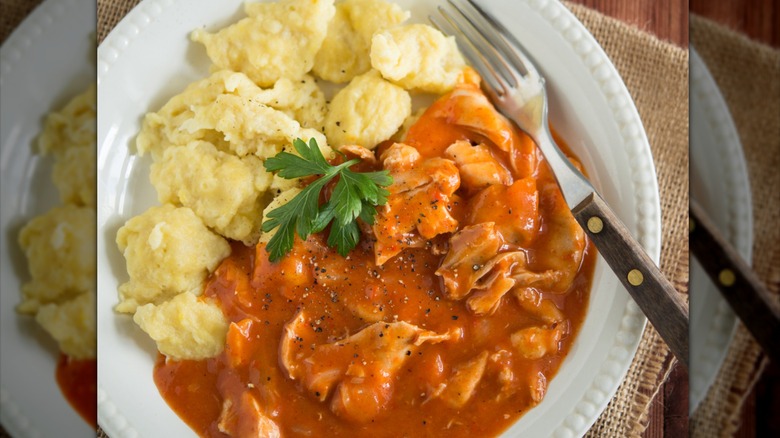
pingpongcat/Shutterstock
Some spices immediately evoke the cuisine of specific nations, and this is very much the case with paprika and Hungary. The central European nation uses paprika to liven up all sorts of dishes — Hungarian goulash is the most famous among them. Chicken paprikash is another of Hungary's classic, paprika-forward recipes, but it hasn't gotten a ton of attention from modern-day chicken lovers outside of the nation that birthed it.
This wasn't always true. In the mid 20th-century, many Americans were well-acquainted with chicken paprikash, particularly as a dish their grandmothers made. For those with Central European and Jewish heritage, chicken paprikash is more of a special occasion dish, often eaten as a Shabbat meal rather than a mid-week dinner. The recipe appeared in American-made cookbooks back then, and traditional ingredients like goose or duck fat for browning the chicken and onions for the sauce, were sometimes left out.
The dish's sauce is made from rich sour cream and often a blend of sweet and hot paprika. Onions, roasted peppers, and a little tomato can also be added. In Hungary, chicken paprikash is often served with a side of homemade nokedli, spaetzle-style dumplings. This is another area in which the Americanization of chicken paprikash could diverge — rice or egg noodles are common stand-ins. Oversimplification of the traditional (and rather labor-intensive) recipe may have hindered chicken paprikash's staying power.
Chicken and corn soup
It's old-school, multi-faceted, and has spanned an eclectic range of cuisines, yet somehow, chicken and corn soup never really made it into the mainstream. The contents are unmistakably throwback in that home cooking, use-what's-on-hand way. Depending on which version you're after, chicken and corn soup can go from super fresh and made from scratch, to a clever layering of processed — albeit flavorful — ingredients. Those who haven't forgotten about chicken and corn soup (or ever knew it at all), usually hold it in a reminiscent regard.
Native Americans made corn soup and New England colonists were big fans of chowder. Recipes combining the two, like Chicken Stewed with New Corn, have been around for centuries. The Pennsylvania Dutch community, known for scratch-made, homegrown cuisine, also claims chicken and corn soup as part of its culinary repertoire. In Hong Kong a dish of sweet, canned creamed corn, and chicken seasoning (or shredded chicken) is a simple, quick-serve meal that has also been recognized in Cantonese cuisine. Chicken and corn soup is out there, you just might have to search around for it.
Mushroom chicken feet noodles
Chicken feet are not a common sight (at least in the Western world), unless you happen upon a dim sum spot that keeps them on the menu. The literally-named dish is a product of Cantonese and Sichuan cuisines from China. Chicken feet have been enjoyed in China since at least the 3rd century B.C. and remain tremendously popular today ... in China. Westerners, and even the new generation in Asia don't take to retro comfort dishes like mushroom chicken feet noodles with the same enthusiasm as eaters of yore.
Chicken feet, also called fung jao, or phoenix claws, are both tender and gelatinous. The traditional cooking method is braising, but they are typically deep-fried in oil first so that the skin on the chicken feet puff up and better absorb the flavors of the braising liquid. The braising liquid used to make mushroom chicken feet noodles includes star anise, Sichuan peppercorns, white pepper, soy sauce, sugar, and plenty of garlic. Shiitake mushrooms are added to the braise and the mixture cooks for hours, although a pressure cooker would reduce this process to about 45 minutes. Some recipes also call for cabbage or bok choy.
For many, the texture of chicken feet isn't appetizing, they aren't meaty like other parts of the chicken. Less people are braising chicken feet for a steamy dish of mushroom chicken feet, but it's one that's worth resurrecting.
City chicken
In tough times, people got super crafty with food and created some interesting recipes that the public embraced — for a little while. City chicken is a prime example of that culinary resourcefulness. During the Great Depression, chicken wasn't as affordable or readily available as other meats like pork, veal, and lamb kidneys. In the ultimate time of waste not want not, city folks in America's Rust Belt (composed of industrial cities in the Great Lakes area) decided to combine these meat scraps, form them into a cylindrical shape vaguely resembling a chicken drumstick, bread it, fry or bake it, and pierce it with a skewer.
City chicken, also called mock chicken, is predominantly thought of as a Polish-American food. It's also one of the Great Depression recipes that wasn't shunned for being a sad food from a sad time. City chicken continued to be reproduced regionally in places like Cleveland and Pittsburgh, but its niche foothold has decreased in the 21st century. The cubed and breaded meat, often served with gravy was reserved for Sunday meals decades after the Great Depression ended. It's still sentimental, especially amongst Americans with Eastern European heritage, but city chicken's modern-day relevance is limited.
Chicken pudding
Chicken pudding's foray into obscurity is a testament to how people's food preferences have changed over time. We still eat a lot of colonial-era foods (like cornbread), but the public's fondness for savory puddings has waned big-time — especially in America. Back in the 1700s though, chicken pudding was it.
Colonial-era chicken pudding relies on simple ingredients and straightforward, subtle flavors. Eggs, milk, flour, and butter give the dish its thick texture, which landed somewhere between a quiche and a cake. Chunks of chicken and chicken stock are added in and a pinch of salt and pepper are the main spices used, thyme and parsley were sometimes added for a little herbaceousness. If you've ever toured a colonial village in the U.S., you know that hearty meals were all the rage ... bold or zesty flavors were not.
Chicken pudding might seem appealing as a winter-warmer kind of dish, but for the most part, it's not big in the U.S. anymore. Savory pies have fared far better. Chicken pot pie, which has origins in Ancient Greece, still has a strong presence in American food culture.
Coronation chicken
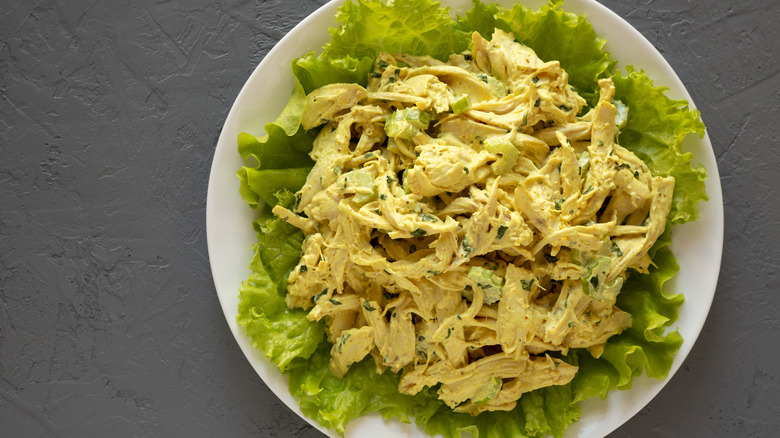
Liudmyla Chuhunova/Getty Images
On June 2, 1953, Queen Elizabeth II took the throne, and for the Brits, the coronation ceremony was a gigantic deal. The occasion was broadcast worldwide and called for great celebration — in the form of a never-before-seen chicken dish. That dish was coronation chicken and it was intended to surprise and delight the United Kingdom.
Coronation chicken was not served at Queen Elizabeth's coronation banquet. Instead, it was part of an official luncheon for the foreign dignitaries that were in London for the occasion. The dish consisted of wine-poached chicken folded into a creamy sauce of mayonnaise, whipped cream, apricot and tomato purée, and red wine. It was seasoned with lemon, pepper, and curry powder. Coronation chicken was invented by Rosemary Hume, a Paris-trained chef and co-founder of the cooking school that catered the luncheon. Due to the facility's smaller size, the luncheon's menu was restricted to cold items.
Hume's coronation chicken was intended to be served alongside a zesty rice salad; but the dish's fate post-luncheon took another turn. It became a sandwich filling. From then on, coronation chicken became best-known as the inside of a curry chicken salad sandwich, often with nuts and raisins mixed in. As a commodity dish of the past, coronation chicken lost some of its original refinement, which was fit for a royal occasion.
King ranch chicken casserole
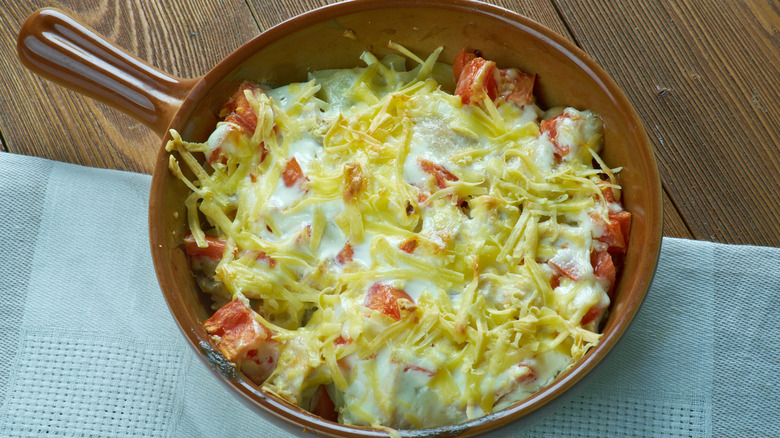
Fanfo/Shutterstock
The marriage of chicken and casserole is a sensible one. Practically every omnivore likes chicken, and a casserole's life mission is to feed a bunch of people. To many mid-century women in the kitchen, the best casseroles existed in the finite space between extra and unhinged. The king ranch chicken casserole that came out of South Texas was actually rather retrained, yet it hasn't managed to captivate modern audiences the way it used to.
King ranch chicken casserole was one of the early foods that laid the groundwork for what we now know as Tex-Mex cuisine. It riffed off a recipe for one-pot creamed chicken with mushrooms and pimentos that was making the rounds in Texas in the 1910s. King ranch chicken casserole has a similar base, but adds grated cheese, onion, tomato, and a layer of corn tortillas. The dish was named for King Ranch, yet there isn't much evidence to support that it was created there.
By the '60s and '70s, king ranch chicken casserole was a fixture of Texan potluck meals. Recipes from that era call for canned cream of mushroom soup (the crown jewel of vintage casseroles) and canned cream of chicken soup. Earlier versions of king ranch chicken casserole likely called for a homemade béchamel-style sauce that was closer to the sauce in antique creamed chicken recipes. A lot of the flavorful chicken casserole recipes of today are elevated or reimagined versions of the king ranch chicken casserole that was trendy decades ago.
Chicken à la king
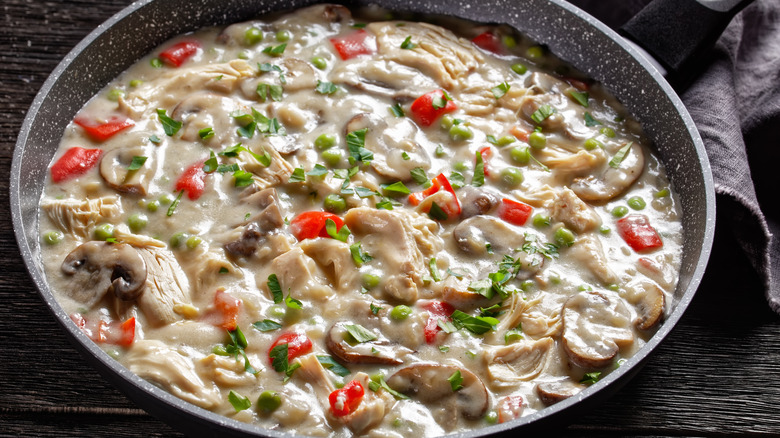
from my point of view/Shutterstock
Throughout the 1900s, the kitchens of upscale hotels were a force in culinary trendsetting. The Bloody Mary, tiramisu, and beef carpaccio all originated in hotels. Chicken à la king also came about that way, it just hasn't permeated public consciousness the way spicy tomato juice and vodka has. The dish was created in the early 20th century at the Brighton Beach Hotel in South Brooklyn. The hotel was a place for city-weary folks to enjoy a waterside respite, and thanks to the hotel's head chef, dig into a lunch of classy comfort food with a French-sounding name.
If a story featured in an old Brighton Beach Hotel brochure is to be believed, the chef prepared chicken à la king for the hotel's proprietor, E. Clark King II, and his wife, practically on a whim. When the pleased couple asked for seconds, the dish was named for the kings and put on the hotel menu the next day. Chicken à la king isn't complicated, its diced or shredded or minced chicken in a béchamel sauce with mushrooms and peppers served over toast (a bed of noodles was a common variation). Within a few years, other swanky NYC hotels like the Plaza, were serving chicken à la king. The city's restaurants started making it too.
How did a chicken dish so popular get so lost? The answer is as simple as it is ambiguous. Over time, people seemed to get tired of eating chicken à la king and moved on to other fashionable foods.
Chicken noodle ring
Back in the day, people were obsessed with pressing food into Jell-O molds no matter how gross it looked. We've all seen the pictures of '50s-era aspics that paired meat and gelatin into a fantastically bad sculptural blob, but a chicken noodle ring perhaps looks even worse. A mere glance of this fleshy, wan monstrosity of gloopy chicken mummy-wrapped in unsauced pasta begs a single question: why?
Let's start with the chicken noodle ring's redemptive qualities. Chicken noodle ring recipes do not call for gelatin, they're simply baked in a ring mold. Baked rings of egg noodles are traditional and common in Jewish cooking and Pennsylvania Dutch cuisine. The Jewish kugel is a beloved baked dish where noodles are bound with eggs, sour cream. A Pennsylvania Dutch recipe from the 1930s calls for noodles to be baked in a Bundt pan in a mixture of milk, flour, egg, and cheese. These don't seem so bad, and yet much of the photographic evidence of retro chicken noodle rings looks totally scary.
Part of the problem is filling the noodle ring with hot creamed chicken. It looks messy and bland — two food words that don't go together. Another issue is the ingredients list. Ketchup shows up in quite a few recipes — why are we baking ketchup? Couldn't they think of using something else? Too many questions and too many cringey photos explain why for most of us, chicken noodle rings are best left in the past.



